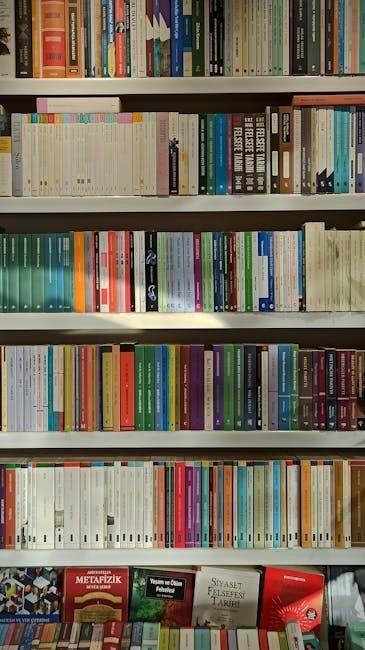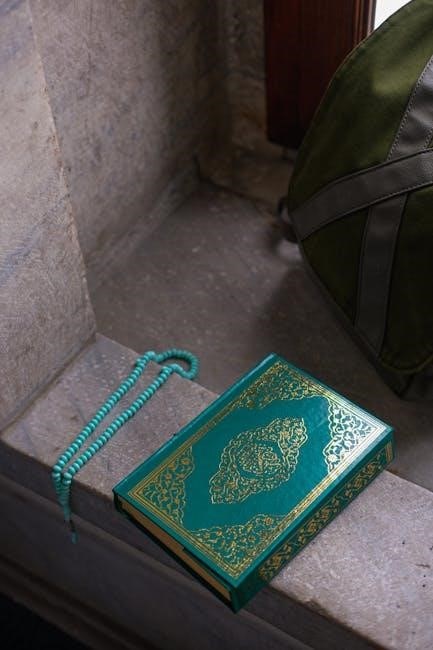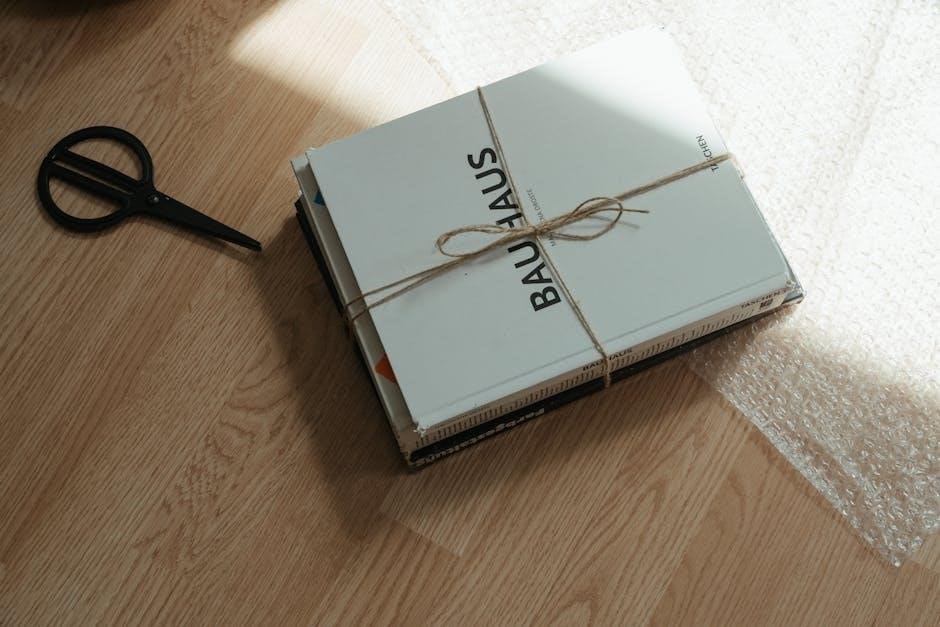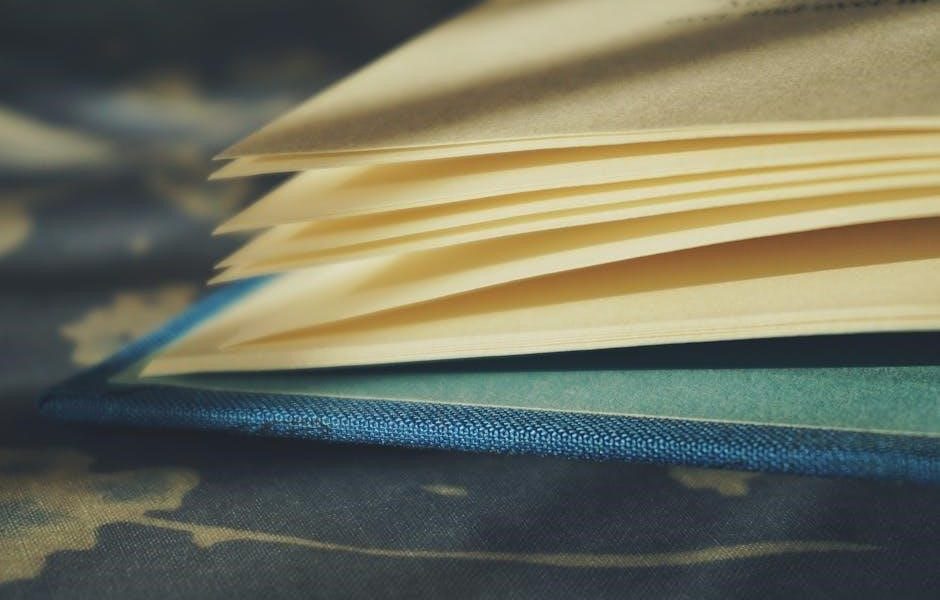Discover the art of transforming paper into meaningful books through step-by-step guides and creative techniques. Explore tutorials for beginners, from simple stitches to intricate designs, and unlock your crafting potential.
What is Bookbinding?
Bookbinding is the art of assembling and securing pages together to create books, journals, or other bound materials. It involves folding, stitching, or gluing sheets of paper into a durable and organized format. This craft allows individuals to transform loose papers into functional and aesthetically pleasing books. Whether for practical use or artistic expression, bookbinding offers a wide range of techniques, from simple stitches to intricate cover designs. It is a versatile skill that combines creativity with precision, making it accessible to both hobbyists and professionals. Bookbinding can be applied to create personalized journals, photo albums, or even professionally finished books, making it a rewarding and creative pursuit.
Why Learn Bookbinding?
Learning bookbinding offers a unique combination of creativity and practicality. It allows you to craft personalized journals, repair cherished books, or create artistic expressions. This skill enhances your ability to produce professional-looking books, whether for personal use or as gifts. Bookbinding fosters patience and attention to detail, making it a fulfilling hobby. It also provides a sustainable way to reuse materials, promoting eco-friendly crafting. With various techniques to explore, bookbinding is a versatile art form that can be enjoyed by people of all skill levels, making it a rewarding endeavor for both beginners and experienced crafters alike.
Basic Materials Needed for Bookbinding
To start bookbinding, gather essential materials like paper, cardstock, glue, and thread. A needle, scissors, and a ruler are also necessary for precision. Fabric or leather can be used for covers, while chipboard provides structural support. Bone folders or similar tools help create sharp folds. Weights and clips keep pages aligned during assembly. Optional items include decorative elements like ribbons or foil stamps. Having a well-organized workspace ensures efficiency. These materials allow you to craft durable, professional-looking books, whether you’re creating journals, scrapbooks, or novels. They form the foundation for various binding techniques, making your projects both functional and visually appealing.

Popular Bookbinding Techniques
Master various methods like pamphlet stitch, saddle stitching, and case binding for durable, professional results. These techniques offer versatility for crafting journals, scrapbooks, and hardcover books with ease and precision.
Pamphlet Stitch Tutorial
The pamphlet stitch is a simple and elegant technique for binding small books or journals. It involves sewing pages together with a basic 3-hole stitch, creating a secure and visually appealing structure. Ideal for beginners, this method requires minimal tools, such as a needle, thread, and a few basic materials like paper and a ruler. The process starts by stacking and aligning the paper, then marking the sewing holes. After sewing, the book is ready to use. This technique is perfect for creating quick projects like notebooks or zines, offering a great introduction to more complex bookbinding methods.
Saddle Stitch Bookbinding
Saddle stitch bookbinding is a popular and straightforward technique for creating small books, magazines, or brochures. It involves folding sheets of paper in half and stapling them along the spine. This method is ideal for beginners, as it requires minimal tools, such as a stapler, ruler, and bone folder. Start by gathering your paper, folding it into sections, and aligning the edges. Then, use a saddle stitch stapler to secure the pages together. For added durability, reinforce the staples with a bone folder. Saddle stitch is perfect for short books, as it allows the pages to lie flat when opened. This technique is quick, simple, and great for small projects, offering a professional finish with minimal effort.
Case Binding for Hardcover Books
Case binding is a durable method for creating hardcover books, ideal for professional-looking results. Begin by assembling materials like paper, cardstock, glue, and fabric or leather for the cover. Measure and cut the boards to fit your book’s height and width. Score and fold the cover material, then attach it to the boards using strong adhesive. Sew or glue the pages together, ensuring a secure binding. Attach the book block to the case by gluing the spine and sides. Allow the glue to dry completely for a sturdy finish. Case binding offers a timeless, elegant look, perfect for preserving memories or creating special editions.
Perfect Bound (Glued) Books
Perfect binding uses strong adhesive to attach pages directly to a cover, creating a modern, paperback-style book. Stack and align your pages neatly, then apply glue along the spine. Attach the cover, ensuring it wraps around the pages smoothly. Clamp the book to allow the glue to set for a secure hold. This method is quick and requires minimal tools, making it ideal for DIY projects. Perfect binding is versatile, suitable for journals, manuals, or art books. With proper technique, it offers a professional finish, making it a popular choice for both beginners and experienced bookbinders looking for efficiency and style.
Coptic Stitch Binding
Coptic stitch binding is an ancient technique characterized by its chain-like stitching visible along the spine. It allows books to open fully flat, making it ideal for journals, sketchbooks, and art projects. Begin by sewing signatures together with a needle and thread, looping through each section’s folds. The exposed stitching creates a decorative element, while the lack of glue ensures flexibility. This method is favored for its durability and aesthetic appeal. With practice, it becomes a versatile and creative way to craft unique, handmade books that stand out for their functionality and beauty, perfect for both practical and artistic purposes alike.
Japanese Stab Binding
Japanese stab binding is a traditional method featuring a simple yet elegant exterior. It involves sewing pages together through pre-punched holes along the spine. This technique is versatile, suitable for both softcover and hardcover books. The visible stitching adds a decorative touch, while the structure remains durable. Ideal for creating journals, scrapbooks, or art pieces, it allows for easy customization with various thread colors and cover designs. A popular choice among bookbinding enthusiasts, Japanese stab binding offers a balance of functionality and artistry, making it a rewarding project for both beginners and experienced crafters seeking to produce beautiful, handmade books.
DIY Bookbinding Projects
Transform paper into personalized journals, scrapbooks, and art journals. Explore creative techniques to craft unique, functional items that reflect your style and creativity through hands-on projects.

Handmade Journals
Creating a handmade journal is a rewarding DIY project that combines creativity with functionality. Start by gathering materials like paper, thread, glue, and a needle. Fold and stack paper sheets into sections, then sew them together using a simple stitch like the pamphlet or saddle stitch. Add a cover made from fabric, leather, or recycled materials for a personalized touch. Decorate the journal with ribbons, buttons, or stamps to make it unique. Many tutorials online provide step-by-step guides, making it easy for beginners to follow along. With patience, you can craft a journal that serves as a treasured keepsake or thoughtful gift.
Scrapbook Binding
Scrapbook binding is an artistic way to preserve memories. Start by organizing your photos and mementos into sections. Use a sturdy material like chipboard or cardboard for the base and cover it with decorative paper or fabric. Sew the pages together with a strong thread, employing techniques like the saddle stitch or coptic stitch. Add embellishments such as ribbons or buttons for a personalized look. Tutorials often include tips on measuring, cutting, and assembling the book. With these steps, you can create a beautiful scrapbook that lasts for years, serving as a unique way to display cherished memories.
Art Journal Creation
Art journal creation combines creativity with bookbinding techniques, allowing you to craft a unique space for self-expression. Begin by selecting mixed-media paper and decorative materials like paint, stamps, and ephemera. Bind the pages using methods such as the coptic stitch or perfect binding, ensuring durability for frequent use. Personalize the cover with fabric, leather, or recycled materials. Add embellishments like ribbons or buttons for a tactile experience. Tutorials often highlight tips for layering designs and integrating personal imagery. This process encourages artistic freedom and experimentation, making each journal a one-of-a-kind reflection of your creativity and personality.
DIY Paperback Book Binding
DIY paperback book binding is a simple and cost-effective way to create your own books. Start by gathering materials like paper, glue, and a needle. Stack and fold the pages into sections, then attach a cover made from cardstock or lightweight fabric. Use a basic stitch or glue to secure the pages together. This method is ideal for personal projects, zines, or small notebooks. Tutorials often emphasize the importance of aligning pages evenly and applying adhesive sparingly; With minimal tools, you can craft a professional-looking paperback book tailored to your creative needs. This technique is perfect for beginners and offers a rewarding, hands-on experience.

Advanced Bookbinding Methods
Explore advanced techniques like French link stitching and leather binding for a polished look; These methods require precision and specialized tools, offering durability and elegance for professional results.
French Link Stitch
The French link stitch is an advanced bookbinding technique known for its strength and flexibility. It involves sewing pages together with a continuous thread that loops around the spine. This method creates a durable and attractive binding, ideal for hardcover books. The process requires precise measurements and careful threading. It’s often used in professional bookbinding for its clean appearance and long-lasting results. Perfect for those looking to create high-quality, custom books.
Leather Bookbinding
Leather bookbinding is a sophisticated technique that combines durability with elegance. It involves wrapping a book’s cover in high-quality leather, creating a protective and visually appealing finish. The process requires precise cutting and shaping of the leather to fit the book’s dimensions. Tools like sharp knives, edge bevelers, and stamps are essential for achieving professional results. The leather is typically dyed and treated to enhance its appearance and longevity. This method is ideal for creating heirloom-quality books, offering a classic and timeless aesthetic. With proper care, leather-bound books can last for generations, making them a cherished possession for book enthusiasts and collectors alike.
Hardcover Bookbinding with Hot Glue
Hardcover bookbinding with hot glue is a modern, efficient method for creating durable and professional-looking books. This technique involves using a hot glue gun to attach the cover to the book’s spine and pages. It’s ideal for DIY projects, as it simplifies the binding process without requiring sewing or complex stitching. The glue provides a strong bond, ensuring the book’s longevity. To begin, prepare your materials, including the book pages, cardboard or chipboard for the covers, and a suitable fabric or paper for the outer layer. Apply the hot glue carefully to avoid excess, ensuring a clean and even finish. This method is perfect for beginners and experienced bookbinders alike, offering a quick yet sturdy solution for hardcover books.
Decorative Book Covers
Decorative book covers add a personal touch to your handmade books, making them unique and visually appealing. Use materials like fabric, leather, or recycled paper, and embellish with ribbons, stamps, or embroidery. Techniques such as foil stamping, embossing, or decoupage can create intricate designs. For a rustic look, incorporate natural elements like leaves or flowers. Experiment with different textures and colors to match your book’s theme. Personalize covers with names or meaningful symbols for a special finish. These artistic touches transform ordinary books into cherished keepsakes, reflecting your creativity and craftsmanship. With endless possibilities, decorative covers allow you to express your style and make each book truly one-of-a-kind.

Bookbinding Tools and Workspace
Gather essential tools like bone folders, awls, and cutting mats. Set up a dedicated workspace with a sturdy table and good lighting for precision and comfort while crafting.

Essential Tools for Bookbinding

A bone folder is crucial for creasing paper and shaping covers. A cutting mat and ruler ensure precise cuts, while a utility knife or scissors handle trimming. An awl or needle pierces holes for stitching, and strong thread or cord binds pages together. PVA glue secures covers and reinforces spines. Bookboard or chipboard provides rigid support for hardcovers, and cloth or paper covers protect the book. Clips or presses hold everything in place while gluing. Optional tools include a sewing frame for even stitching and a jig for consistent hole placement. These basics help craft durable, professional-looking books, whether you’re making journals, scrapbooks, or novels.
Setting Up a Bookbinding Workspace
A well-organized workspace is essential for efficient bookbinding. Begin with a sturdy table or desk to accommodate tools and materials. Ensure good lighting with a desk lamp or natural light for visibility. Use trays or containers to keep tools like bone folders, needles, and glue organized. A cutting mat with a ruler and utility knife should be within easy reach. Store paper, bookboard, and fabric in nearby shelves or drawers. Safety is crucial—keep sharp objects securely stored and have a waste bin for scraps. A comfortable chair and wrist support can prevent fatigue. A dedicated, clutter-free area enhances focus and creativity, making the bookbinding process both enjoyable and productive.
Tips and Tricks for Beginners
Start with simple projects, practice patience, and use everyday materials. Watch tutorials for clear guidance and experiment with scrap paper to refine your skills before final projects.
Choosing the Right Paper
Selecting the right paper is crucial for bookbinding. Consider weight, texture, and durability. Thicker papers like 80-100 gsm are ideal for pages, while thinner papers work well for endpapers. Textured or colored papers can add aesthetic appeal. Ensure all pages are consistent in size and finish to maintain a professional look. Acid-free papers are recommended for longevity. Experiment with different types to find what suits your project best. Proper paper choice enhances both functionality and visual appeal of your handmade books.
Measuring and Cutting Accurately
Accuracy is key in bookbinding. Use a ruler or measuring tool to ensure precise cuts. Stack paper neatly and align edges before cutting. A craft knife or sharp blade works best for clean edges. Always cut on a protective surface, like a cutting mat. Measure twice to avoid errors. For uniformity, mark pages with a bone folder or similar tool. Double-check measurements before cutting to prevent waste. Proper alignment ensures pages fit seamlessly. Safety first: handle sharp tools with care. Accurate cutting sets the foundation for a professional-looking book. Practice makes perfect—take your time for precise results every time.
Troubleshooting Common Mistakes
Common mistakes in bookbinding often stem from rushed steps or misalignments. Uneven stitches or loose threads can weaken the bind; tighten stitches and re-sew if necessary. Glue spills can be cleaned with a damp cloth before drying. Pages not laying flat may need re-folding or adjusting the spine alignment. If covers are crooked, reattach them carefully, ensuring proper fit. For wrinkled covers, gently iron them on a low setting. Mistakes are opportunities to learn and refine techniques. Patience and attention to detail are key. Review instructions and practice on scrap materials to master the process. Every project brings improvement, so embrace the learning journey.

Digital Resources for Bookbinding
Explore a wealth of digital resources for bookbinding, including YouTube tutorials, detailed blogs, online courses, and downloadable guides to enhance your crafting skills.
Best YouTube Tutorials for Bookbinding

YouTube offers a treasure trove of bookbinding tutorials, catering to all skill levels. Channels like DAS Bookbinding and Jessica of Greenleaf & Blueberry provide clear, step-by-step guides. Beginners can start with the pamphlet stitch or saddle stitch tutorials, while more experienced crafters can explore intricate methods like the coptic stitch or Japanese stab binding. Many creators share tips on materials, tools, and troubleshooting common mistakes. Additionally, some tutorials focus on creative variations, such as using hot glue for hardcover binding or crafting unique DIY book projects. These videos are perfect for learning at your own pace and discovering new techniques to enhance your bookbinding journey.
Online Courses for Bookbinding
Online courses are an excellent way to master bookbinding, offering structured learning experiences. Platforms like Udemy and Skillshare feature courses tailored for beginners, covering foundational techniques such as pamphlet stitching, saddle stitching, and case binding. These courses often include video lessons, downloadable guides, and step-by-step instructions. Many instructors are experienced bookbinders who share tips on materials, tools, and troubleshooting. Advanced courses delve into leather binding, decorative covers, and intricate stitching methods. With flexible pacing, learners can practice techniques at home and access resources anytime. Whether you’re crafting journals or hardcover books, these courses provide a comprehensive path to refining your bookbinding skills and creating professional-quality pieces.
Downloadable Bookbinding Guides
Downloadable bookbinding guides are an invaluable resource for crafters, offering detailed step-by-step instructions and visual aids. These guides, often available as PDFs or eBooks, cover various techniques, from basic stitches like the pamphlet stitch to advanced methods such as case binding and leatherworking. Many guides include patterns, material lists, and troubleshooting tips, making them perfect for both beginners and experienced bookbinders. They provide flexibility, allowing learners to practice at their own pace and access information anytime. Popular guides also include templates for creating journals, scrapbooks, and art journals, ensuring a comprehensive learning experience. With downloadable guides, you can master bookbinding techniques conveniently and creatively, transforming your projects into professional-quality pieces.

Bookbinding Communities and Inspiration
Explore online communities, YouTube channels, and Instagram accounts dedicated to bookbinding. Discover inspiring projects, tutorials, and tips from enthusiasts worldwide. Join forums to collaborate and exchange ideas, fostering creativity and skill refinement in this timeless craft.
Joining Bookbinding Groups
Joining bookbinding groups is a fantastic way to connect with fellow enthusiasts, share ideas, and learn new techniques. Online forums, social media groups, and local meetups offer valuable resources and inspiration. Engage with communities on platforms like Facebook, Reddit, or specialized bookbinding forums to discover tutorials, tips, and feedback from experienced members. These groups often host challenges, workshops, and collaborative projects, fostering creativity and skill improvement. By participating in these communities, you can gain confidence, troubleshoot common mistakes, and stay motivated on your bookbinding journey. Connecting with others who share your passion can also lead to meaningful friendships and a deeper appreciation for the craft.
Following Bookbinding Blogs
Following bookbinding blogs is a great way to stay inspired and learn from experienced crafters. These blogs often feature step-by-step tutorials, tips, and tricks for various binding techniques. From simple DIY projects to intricate designs, bloggers share their expertise, providing valuable insights and resources. Many blogs include photos, videos, and downloadable guides, making it easier to follow along. They also showcase creative ideas for journals, scrapbooks, and art journals, encouraging you to experiment with different materials and styles. By following these blogs, you can gain new skills, discover trends, and stay motivated to continue your bookbinding journey. They are a treasure trove of inspiration and knowledge for crafters of all levels.
Instagram Accounts for Bookbinding Inspiration
Instagram is a vibrant platform for bookbinding enthusiasts, offering a wealth of inspiration and creativity. Follow popular accounts dedicated to bookbinding to discover stunning handmade journals, intricate stitches, and unique cover designs. Many accounts share step-by-step tutorials, behind-the-scenes looks at their creative processes, and tips for improving your craft. Hashtags like #Bookbinding, #HandmadeBooks, and #BookArt can help you find inspiring content. These accounts often feature beautiful photos and videos of leather-bound tomes, coptic stitch journals, and perfectly crafted paperbacks. By exploring these profiles, you can gain ideas, learn new techniques, and connect with a community of passionate bookbinders worldwide. They are a great source of motivation to try new projects and refine your skills.
Bookbinding is a rewarding craft that combines creativity and precision. With these tutorials, you’ve unlocked the tools and techniques to create beautiful, lasting handmade books. Enjoy the journey!
Final Thoughts on Bookbinding Tutorials
Bookbinding tutorials offer a gateway to creativity and craftsmanship, allowing anyone to transform simple materials into meaningful, lasting books. Whether you’re crafting journals, scrapbooks, or art pieces, these guides provide clear, step-by-step instructions to help you master various techniques. From basic stitches like the pamphlet and saddle styles to advanced methods such as case binding and leatherworking, the tutorials cater to all skill levels. They emphasize precision, patience, and the joy of creating something with your own hands. By following these tutorials, you’ll not only produce beautiful books but also gain a deeper appreciation for the art of bookbinding. Start your creative journey today and bring your ideas to life, one stitch at a time.
Encouragement to Start Your Bookbinding Journey
Embrace the world of bookbinding and unlock your creative potential. With simple tools and materials, you can craft beautiful, handmade books that reflect your unique style. Whether you’re creating journals, scrapbooks, or art pieces, bookbinding offers endless possibilities for self-expression. Don’t be intimidated—start with basic tutorials and gradually explore more complex techniques. The satisfaction of holding a book you made yourself is incredibly rewarding. Join a community of bookbinding enthusiasts, share ideas, and inspire others. Take the first step today and discover how bookbinding can become a fulfilling hobby or even a career. Your creative journey begins here!
